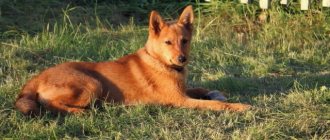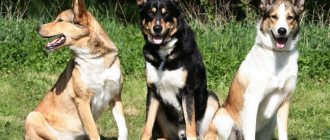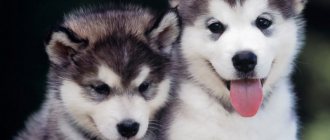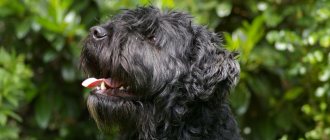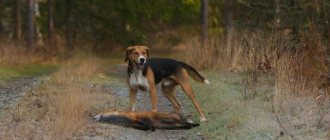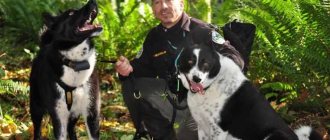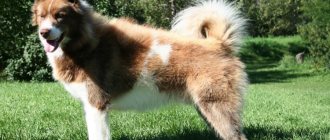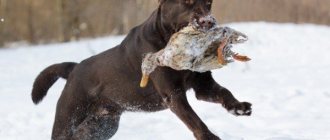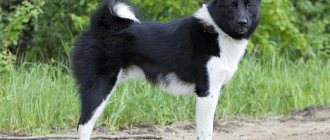Origin story
The Karelo-Finnish Laika adapts to any weather conditions
This breed of dog was bred in the territory of the former USSR. Representatives of domestic native breeds from the northwestern territories, as well as imported Finnish Spitz, took part in its formation. The ancestors of the Karelian-Finnish huskies are considered to be the Old Korelian, Olonets and Finnish “bird” dogs, of which there are many in the Arkhangelsk and Leningrad regions, in Karelia and neighboring Finland.
At one time, the breed was formed naturally in a limited area. Red-haired hunters successfully obtained food and lived in the open air. In the process of natural selection, the most intelligent and hardy individuals with good hunting skills remained. Later, people used them to hunt for commercial forest birds and fur-bearing animals.
A pack of Karelian-Finnish dogs can even cope with a bear.
At the end of the 19th century, Finnish hunters H. Sandberg and H. Roos brought two such huskies to Helsinki. 12 years later, such dogs were recognized as a separate breed and registered as the Finnish Spitz. By the middle of the last century, “saffron milk caps” became incredibly popular. They were acquired for hunting and as companion animals.
In the 20s of the last century, the Soviet Union began to think about breeding “their own” breed. Breeders began work, the result of which was the Karelian-Finnish husky, which has excellent commercial qualities. At the same time, a temporary breed standard was adopted.
During the war, the number of Karelians decreased. In the post-war period, work on the breed in the USSR resumed, and in 1959, the dog obtained from the mating of a mixed Karelian-Finnish husky and a Finnish Spitz became the champion of a huge country, after which the breeders decided to more actively use Finnish pedigree dogs in the selection.
In 2006, the Russian Kynological Federation (RKF) and the Finnish Kennel Club (SKZ) came to a joint decision to consider the Karelian-Finnish Laika and the Finnish Spitz as one breed - the “Finnish Spitz”.
Not all breeders and dog handlers in Russia approved of this decision, because in fact it meant the disappearance of the Karelian-Finnish breed. However, the fact that the Finnish Spitz is standardized by the international canine organization FCI has made it possible for dog owners to show their pets at international exhibitions and competitions.
Currently in Russia there are many supporters of the domestic breed concept who, as before, adhere to the “Soviet” standard of the Karelian-Finnish dog and do not approve of the use of Finnish Spitz in breeding.
Requirements for the Karelo-Finnish breed when hunting
When hunting with the Karelian-Finnish breed, the key factor is its viscosity to the animal or game. The dog should strive to reach the bird through the grass or water, chase it, lift it on the wing and, after a well-aimed shot, find it.
It is important to note that when hunting game birds, one of the most important elements of the hunt is its presentation. There are requirements for dogs to qualify for a field diploma. The maximum and at the same time minimum score for obtaining a 1st degree diploma is 20 points. For this assessment, the husky must flawlessly rush into the water, look for the bird, find it and bring it to the feet of the owner.
Dog tests for birds and fur-bearing animals are usually carried out 2-3 weeks before the start of the hunt. Such deadlines are due to the fact that the young animals have already grown up and the husky cannot harm them. Almost all Karelian-Finnish ones have a mild taste, thanks to which the bird or animal remains alive.
Description and breed standard (colors, height at withers, weight)
The fur on the pants and tail is especially thick
The dog's coat has a glossy sheen. It is long and thick along the body, but short on the head and legs. The cover is the toughest on the neck, shoulders and back. The undercoat is soft and rich.
Standard breed parameters:
| Floor | Ideal height at withers (cm) | Ideal body weight (kg) |
| Male | 47 (± 3) | 12–13 |
| Bitch | 40 (± 3) | 7–10 |
Colors include all shades of red: from golden to fiery brick. At the same time, the color on the back is always brighter than on the chest, belly, tail and back of the thighs.
The presence of white markings on the paws and the same markings on the chest, and the presence of black hair on the ears and around the eyes, as well as along the spine, are considered acceptable
Character
With proper upbringing, your Karelian will be able to understand you and your mood
Karelian-Finnish dogs have a wonderful character, the main features of which are:
- mobility, cheerfulness and performance;
- courage, but not reckless;
- moderate aggressiveness towards strangers;
- attachment to the owner and his family;
- the ability to sense the owner’s mood and behave correctly.
The red husky always suffers from separation anxiety, and when handled roughly, it becomes stubborn and difficult to control.
With proper training, these dogs get along well with other animals living in the house and are also friends with children. They are attentive and if they consider something dangerous, they will certainly let the owner know by barking. Karelian-Finnish dogs have strong nerves and a good memory. They are distinguished by their loyalty and friendliness, which is why in Europe and the USA they are considered one of the best companion dogs.
Care and maintenance
The Finnish-Karelian husky feels great in an enclosure; it is important to provide all the necessary conditions
The dog can live in an enclosure, but adapts perfectly to the conditions of an apartment. Living under the same roof with other people has certain advantages. The dog begins to understand the person faster and better.
When caring for your husky, it is important to remember that:
- periodic deworming and vaccination of the animal is necessary;
- she needs her own permanent place, where there is comfortable bedding and a bowl of water. It is important that it is not located in a draft.
Working dogs must be periodically treated with flea and tick preventatives. You can simply provide her with a collar with anti-parasitic impregnation. More information about caring for the coat, as well as claws, eyes and teeth, will be discussed in the section on grooming.
What to feed
Dogs must have raw bones.
The red husky is not picky about food. Her optimal diet consists of foods such as:
- lean meat, cut into small pieces, which can occasionally be replaced with sausage and sausages that do not contain pork;
- raw bones - large, with meat remains, but without sharp edges;
- offal. In their raw form they can be a common food, and in their dry form they can be used as a delicacy;
- porridges made from buckwheat, millet and rice, which can be prepared either with lean broth or with the addition of a small amount of vegetable oil;
- fermented milk products, including cottage cheese;
- fresh, boiled and dry vegetables and fruits;
- rye bread crackers.
You should not give your dog:
- tubular bones;
- fresh milk;
- butter;
- sweets.
As for dry food, breeders' opinions are divided. On the one hand, it is better to feed a hunting dog natural food, but on the other hand, special food has a complete and balanced composition, and also saves time. Experts believe that both options are acceptable, the main thing is to stick to only one of them. A mixed feeding regimen can lead to serious digestive disorders, since natural foods and prepared foods are digested differently.
Grooming
Caring for the Karelian-Finnish Laika is not particularly difficult:
- Its fur does not have a strong specific odor, but needs the attention of its owner. During the period of autumn and spring molting, it is necessary to comb it every day with a comb and a slicker brush. In winter and summer, weekly brushing is enough. Dull and falling fur, as well as the appearance of dandruff, can mean a deficiency of vitamins and microelements in the menu, and also indicate a food allergy.
- The dog is bathed twice a year, and also before participating in an exhibition or when it is heavily soiled. Frequent water procedures are undesirable, as they remove the natural protective composition from the dog's coat. After the dog swam in a natural body of water during a hunt, it must be doused with clean water. The fur of Karelian-Finnish huskies is not cut or plucked.
- Nails should be trimmed every month with a medium nail clipper and then cleaned with a nail file. The pads of the toes and heels are inspected and wiped with a wet cloth after each exit.
- Eye care is required if mucus accumulates in the corners. In such cases, you should carefully wipe them with a clean piece of gauze soaked in warm chamomile infusion. If there is excessive lacrimation and pus discharge, the animal should be shown to a veterinarian.
- Teeth are cleaned using special chewing bones. Solid foods and fresh tomatoes will be an excellent prevention of hard plaque.
- Ears also cannot be ignored. They should be inspected daily for foreign bodies and damage, and wiped from the inside (shallowly!) 2-3 times a month with a clean, damp swab.
Education and training
The “Sit” command is one of the basic ones, dogs learn it quickly
The dog is taught the first commands from the age of five months, when it can already consciously concentrate its attention on the human owner.
Hunting training should begin with exposure to animal skins and bird feathers. The dog must smell them and taste them. It is very important from puppyhood to accustom the dog to sounds similar to a gunshot. As for animal baiting, it is better to introduce it closer to six months of age. Training begins with small animals and birds, and then shows larger ones. To stimulate the development of hunting qualities in a dog, it is allowed near live animals or their carcasses. Hunting techniques are better learned when the puppy is paired with an experienced dog.
To prevent their huskies from getting bored, they need games and long runs, as well as trips to nature. This is especially true for indoor dogs.
It is important to raise your pet so that he feels the primacy of a person and treats him as a leader. Otherwise, problems with obedience are likely.
Diseases and treatment
Despite the fact that these dogs are distinguished by their endurance and good health, they are predisposed to the following ailments:
- dislocations of the knee joint;
- eye diseases;
- allergies to certain foods;
- epilepsy.
Advice on prevention and treatment can be obtained from a veterinarian.
How long do they live?
It is believed that dogs of this breed live 10–12 years, and with proper maintenance they reach 15 years of age.
Nataska
Laikas have a hunting instinct from birth. They chase prey with pleasure, but for this dog to become your hunting assistant, you need to train a lot and for a long time.
It is worth starting training with a small animal. The best option is squirrel. After all, it is during the hunt for this animal that she will have to demonstrate most of the qualities necessary in the matter. This is surveillance, viscosity, voice. As soon as the dog learns to work well with protein, you can begin to master other animals. The few squirrels that your husky finds first need to be shot so that she can see the real fruits of her work. But do not let him tear the animal, and if you notice such behavior, stop it immediately.
One of the most popular breeds for hunting is the West Siberian Laika. Her training must be carried out on a specific animal. Only when she has mastered it, move on to another. Ideally, for the West Siberian husky, training should be carried out in pairs with a more experienced animal, which will not allow it to switch to a hare while chasing a wild boar.
After this, you can begin training the husky on the badger. This animal is nocturnal; only at dusk does it go out to feed, making sure that there are no dangerous enemies nearby.
Badger training can be carried out as early as five months, preferably through a cage. It is arranged in such a way that neither the puppy nor the badger is harmed. At seven months they begin baiting in a clearing with a working female, controlling the process.
Using a non-contact method, you can accustom your puppy to the smell and sight of a badger as early as three months, but it is important not to let your husky get used to such an acquaintance.
Breeding
Finnish-Karelian husky puppies are very playful, sometimes it is very difficult to calm them down
The red husky is very popular in the Nordic countries and in the northwestern part of our country. This explains the large number of nurseries breeding these dogs.
A real Karelian-Finnish Laika, whose breed will be documented, can be bought;
- from breeders who breed Karelians;
- from owners who, through kennel clubs, find a match for their pet, resulting in a purebred litter.
Mating
In accordance with the rules of breeding, it is allowed to allow a dog to be mated for the second, or better yet, the third heat, in this case:
- the bitch must be dewormed in advance and vaccinated no later than 8 months ago;
- It is important that the dog is healthy, since the condition of its offspring depends on this.
Gestation of puppies lasts 62–65 days, but sometimes lasts up to 72 days. The dog is a low-fertility breed (1–6 babies per litter), so pregnancy may be barely noticeable even in later stages.
Caring for puppies
It is important to start properly caring for dogs from birth.
Puppies should be fed mother's milk until 1–2 months, although it is not uncommon for the breeder to feed the litter additionally from 3 weeks. This is done with the aim that the future owner, buying, for example, a one and a half month old pet, will receive a more or less independent puppy, independent of the mother. However, it is important to take care of the health of the bitch, so weaning the babies should occur no earlier than 1–1.5 months.
The main food of a young husky is raw meat in pieces, except for pork, which should not be too much. In addition, there are other nutritional rules:
- At the age of 2-3 months, large, smooth bones or bones with meat are already allowed so that the puppy can “work” with them. Chicken is given raw without bones, as they can injure the esophagus.
- Cereal porridges are slightly salted, diluted with broth or flavored with meat, otherwise the dog will not show interest in food.
- By-products are not given to small children, as they have a relaxing effect on the intestines.
- As for fermented milk products, vegetables and fruits, they are used as for adults.
- It is important to accustom your dog to greens from puppyhood, later it will be much more difficult to do.
- It is better to take quail eggs (1-2 pieces) and give them once a week.
- Fish is also given once a week, and sea fish is fresh, and river fish must be boiled.
It is important to remember that your dog should always have fresh water in his bowl. The food left after feeding should be removed after 15 minutes so that the puppy gets used to the regime.
As for the exact number of feedings, it depends on the age of the dog:
| Age (months) | Optimal number of feedings |
| 2–3 | 5 (small portions) |
| 2–3 | 3–4 |
| 4–7 | 3 |
| 8 and older | 2 |
In addition to proper nutrition, the owner’s concern is to remove worms from the pet from the age of one and a half months, as well as vaccinate the dog in accordance with the schedule:
- at 2 months - from plague and enteritis, followed by devaccination;
- at 6-7 months - from rabies after a complete change of teeth.
Vaccinations, unfortunately, will not fully protect your dog from health problems, so you should protect your pet from hypothermia and fatigue.
It is important to keep your puppy away from larger, stronger dogs. In addition to the fact that this is traumatic, their aggressiveness can permanently discourage a husky from communicating with its relatives.
Characteristics
The first thing to note as a characteristic feature of the Finnish Spitz is its color. International standards describe it as a golden brown or bright red color. Deviation from these colors is considered defective, except for light colors. It is defined as an undesirable color. The length of the coat, its condition, or rather its density, stiffness and raisedness are also considered indisputable signs of purebredness.
Described by international standards as a golden brown or bright red color
Other standard features of the description of the Karelian-Finnish Laika are also considered:
- Head. Wedge-shaped. A pronounced transition to the muzzle. Not very thick, fully colored lips.
- Eyes. The color is light or dark brown. The shape of the eyes is oval, the inner corners are slightly lowered towards the bridge of the nose.
- Nose. The predominant color is black, but brown is also possible.
- Teeth. Strong, with white enamel, have the correct bite.
- Ears. Triangular shape, standing.
- Limbs. The muscles are dry, the joints and bones are strong. It is advisable to remove the fifth toes on the hind legs during puppyhood.
- Tail. Has the shape of a donut.
Karelian-Finnish Laika dogs are very active, and with proper training they can become a reliable assistant for a hunter.
Hunting with the Karelian-Finnish Laika
The Karelo-Finnish Laika is ideal for hunting and is capable of catching several species of animals.
Laikas are intended for commercial hunting. They take fur-bearing animals, large forest and swamp birds, ungulates and even bears.
Representatives of this breed are characterized by the following during hunting:
- they track, bark loudly and slow down the beast;
- lift the bird easily;
- successfully find wounded animals;
- bring booty to their master;
- without fear they climb into holes and jump into the water.
Karelians have excellent instincts, they have excellent orientation, and at the same time they are passionate and resilient. Hunting with this dog is exciting and productive regardless of the time of year:
- Capercaillie and black grouse are caught in the summer, as well as in early spring and autumn. Early in the morning or at sunset, when the boar bird comes down to eat, the dog is set on the trail. Having discovered it, she leads the hunter and scares away the bird.
- Sable, marten and squirrel are hunted in the taiga in October-December. Laika takes the trail, finds the animal and drives it up a tree. Trying to escape, he jumps to another and further. The dog chases him with a loud bark until the animal ends up on a trunk from which it is impossible to jump to the next shelter.
- They go moose hunting in winter, at the very beginning. The dog detects the animal, barks at it so that the owner is aware, and then pursues the prey silently. To stop the elk, the Karelian runs forward with a loud bark, but never gets too close and does not attack.
As for hunting foxes and hares, it is less productive there, although much depends on the individual qualities of the dog.
Hunters of Karelia look forward to the opening of the autumn hunting season with special impatience, because it is preceded by a long preparation of hunting equipment throughout the summer, anticipation and anticipation of the opening of the hunting season, as a kind of great sacrament, known only to people dedicated and involved in the most ancient human craft.
May the “greens”, animal rights activists, vegetarians and those who do not accept any killing of animals and birds in the wild forgive me. Such is human nature that one in a hundred necessarily becomes a hunter. And this is how a real hunter differs from all the rest of the “living people” - those who are indifferent or deny hunting, that he does not just get game, but throughout his entire hunting life he takes care that the animals and birds in the forests of Karelia do not disappear, but multiply.
This is not only strict adherence to the rules of the hunting off-season. This also includes the construction of salt marshes for elk and elk, the installation of fluttering areas and pebbles for upland game, long trips to winter route surveys and much, much more that ordinary hunters do every year. True, unlike the hunt itself, this part of their feasible work for the benefit of nature remains “behind the scenes”, in the shade of the spruces and pines of the Karelian taiga...
Probably the second half of August, when the hunting season opens in Karelia, and the first half of September is the most emotional time for any hunter. And in particular, it is full of events for owners of hunting dogs, from under which in our area it is customary to obtain upland game.
It has long been time-tested that the ideal dog for hunting upland game in the forests of Karelia is the Karelian-Finnish Laika - an active, emotional, fiery red dog, devoted to its owner until death. Karelian-Finnish women are unusually smart and quick to learn. Literally from the first hunts, the dog begins to understand what is required of it; it is distinguished by a broad search, well-developed horse sense, tirelessness and hunting passion.
I had experience of hunting with West Siberian huskies, but I didn’t like them as much in hunting as Karelian-Finnish dogs. Once I was hunting with a Siberian, and she literally overwhelmed me, being distracted all the time by squirrels. But nothing can be done, every time I had to respond to her calling bark to make sure that she was barking at the squirrel again, and to distract her from this, in her opinion, serious process. It ended up that I ended up missing the wood grouse, which she finally barked at. I did not feel a change in her intonation and approached her without hiding, thinking that this was another squirrel...
But the male Karelian-Finnish husky, whom I took when he was still very small and fed from a nipple (my mother got sick and her milk disappeared), I really liked during the hunt. His name was Velly (brother - translated from Karelian), I took him on the first hunt in his life at just five months old. He dragged him without any hope that he would start working - he was too young, but rather in order to accustom him to long, twenty-kilometer marches through the taiga and to the sound of a gunshot. This is important for a hunting dog, because a dog once frightened by a shot will never work again and will shy away from weapons all its life.
The weather that year at the end of August was magnificent, the morning was foggy and quiet, the day promised to be warm and sunny. We walked with Valley along an old logging road overgrown with bushes for about a kilometer before a brood of grouse took off from the side of the road and deep into the forest. The summer then was plentiful and well-fed, the grouse looked like fully grown birds - heavy, noisy, often flapping their wings.
I squatted down, knowing from experience that the brood would not fly far and would sit on the nearest trees. In the surging adrenaline and excitement of the hunt, I didn’t even notice how my dog rushed after the brood.
A few seconds later I heard his clear, very neat, even somewhat hesitant bark. Continuing to move along the edge of the forest on all fours, in a gap in the bushes I noticed the object of barking: a black grouse was swaying, sitting on the top of a low spruce and looking with curiosity at Welly, who, in turn, was lying under the tree on his belly and, raising his muzzle, barked at the unknown give him a bird.
The target was about forty meters away, and the “full choke” attached to the barrel of my Saiga guaranteed a hit. A shot - and the braid fell right into the dog’s paws. The rest of the brood, alarmed by the sound of the shot, flew off the branches and went deeper into the thicket of the forest.
When I approached Valley, he was still lying on his belly. True, now the wings of a black grouse were visible from under it. The dog simply covered him with his body, not allowing the bird to escape on the ground, if anything. The dog shook his tail and looked at me questioningly: “What should I do next, master?”
Generously praising and stroking the distinguished dog, I carefully removed the prey from under him. He gave him the bird to pat so that Wellie could enjoy the smell of the trophy and pluck as many feathers from it as he wanted. As a reward, the dog received a paw - this is how I was taught to thank a dog for a caught bird by an old Finnish hunter, whose experience of hunting with huskies was measured not in years, like mine, but in decades.
I don’t know who had more joy that day - me or my dog, but I soon had to be convinced again that this did not happen by chance.
I had barely packed my loot into my backpack when Welly, possessed by the excitement of the search, rushed further along the side of the forest road. Karelian-Finnish huskies have a very unique, wide circular search. The dog goes far ahead, exploring the area in a circle. Sometimes she returns in a straight line (superior instinct!) with a check to the owner and again rushes into the search.
There is no point in distracting Karelian-Finnish dogs during the search, even if the dog goes far ahead. You must understand that her ideal tool – her nose – always keeps control of the owner’s location. Even a kilometer away from a person, it is enough for a husky to touch the air with its nose to accurately determine its location and return strictly in a straight line. Such is the nature of these unusually sensitive and intelligent dogs.
I heard my Valley’s secondary bark after about forty minutes of moving along the road. The barking came from the lowland, in which a rather wide “bald” swamp began. Along the shore of the swamp, the forest was low, but very dense, here and there mighty pines burst upward from this undergrowth. It was from there, from the depths of the undergrowth, that Welly barked.
Quite quickly, having crossed the sparsely treed space to the undergrowth, I began to carefully make my way through the pine palisade, getting closer and closer to the source of the barking. I noticed Welly from about sixty meters away. His bright red fur fussed about in the gaps of the undergrowth. Wellie circled around a tall, ripe pine tree. I did not immediately see the capercaillie, comfortably settled at the level of the first tier of tree branches. He gave himself away by movement: the bird was not that nervous, she was trying to keep the dog in her field of vision, and to do this she had to walk back and forth along the branch.
Welly played out in earnest. He wagged his tail, pressed his chest against the moss, tilted his head in a mannered manner, all the time barking loudly and running from place to place. In general, I tried my best to distract the capercaillie’s attention. While I, holding my breath, was approaching the shot, Welly never, not even with a glance or half a glance, betrayed my presence. My biggest fear was that, due to inexperience, the dog would start jumping on the tree trunk and scratching it. The bird cannot withstand such vibration transmitted to its paws and instantly flies off the tree.
But Welly behaved perfectly. He was so captivated by the barking at the bird that it seemed to him that he didn’t care at all about either the tree or me. I, having chosen a position for shooting, tried to calm myself down. It didn’t work out very well: the fly jumped and jumped in time with my desperate heartbeat, and in order to finally aim properly, I had to lean on a branch.
Having finally caught the moment when the swinging front sight went under the capercaillie, I fired. I didn’t even see the bird fall, but only heard the dull thud of the carcass hitting the ground and the fluttering of its wings. The dog's barking instantly stopped.
This time I approached Valley much more slowly than the day before - let him be alone with the prey for a while. The dog, like the last time, was lying on its stomach (this manner remained with Valley as his own hunting “trick”), only this time his jaws were tightly closed on the wood grouse’s neck.
As I approached, I made sure that the capercaillie was no longer showing signs of life, and began to praise the dog. For a while, Welly just looked at me with mischievous eyes and wagged his tail, still not letting go of his prey from his mouth. But I was determined not to take the game away from the dog by force, but to force him to leave the bird and come to me.
After a couple of minutes of laudatory speeches, the dog’s heart melted, he abandoned the capercaillie and came up to me for a petting. Continuing to praise and stroke him, I picked up my prey. The capercaillie was quite large, about four kilograms, and was clearly not of this year. After cutting off the paw with a knife, I again thanked my dog for a job well done.
We didn't hunt anymore that day. We drank tea by the fire, picked some mushrooms and returned home. Many hunters I know were distrustful of my words that my dog started working at five months. Moreover, it’s a male (among Karelian-Finnish Laikas, it’s the females who are particularly capable of working), but the hunted capercaillie itself was a witness to our success.
Sometimes it’s possible to take a young black grouse “for fun”, without a dog. If you understand well the rules of bird behavior in a brood. The first takeoff is always short; the black grouse sits nearby to assess the danger that has frightened it. And if at that moment you didn’t have time to shoot, then it’s a lost cause: then you can chase the brood for an hour or two – the bird will no longer let you get within shooting range.
Another thing is the capercaillie. This is an overly cautious bird; in my entire hunting life I have never been able to take it without a dog, simply by “self-stomp” and randomly flushing it from the ground. Even after the first scare, the capercaillie goes far and to a guaranteed safe distance. I haven’t heard that other hunters managed to get a capercaillie just like that - out of the blue and without a dog.
One day a funny incident happened while fishing. It was at the end of July, during the off-season. My sister and her friend from Estonia came to visit me and they asked to go fishing. After fishing to our heart's content in a quiet creek in the morning, we went to the hut to have a snack and drink tea. Welly, of course, was accompanied by us.
We had lunch at the hut, sipped tea and had a leisurely conversation, when suddenly my sister’s friend, looking out the window, said in surprise: “Oh, girls, there’s a horse!”
“What kind of horse could there be in the forest?” — my sister looked out the window: “Andryukha, there’s a moose there!”
I quickly thought of grabbing my sister’s camera from the table, which she carried with her everywhere. Having jumped out of the hut, we were simply dumbfounded: a young elk was standing about twenty meters from us, and Velly was silently, intently “ringing” him, all the time staying in front of his muzzle and not allowing him to go into the forest.
The elk looked at us somehow a little hunted and tired, it was clear from everything that Welly had specially driven him to the hut from somewhere deep in the forest. He was breathing heavily and noisily, recovering from the run. I calmly took a few shots and called the dog. At first, Wellie didn’t want to come over, but then he reconciled himself - he came up, lay down at my feet and allowed me to take him by the collar. He never looked again in the direction of the elk, apparently realizing that there would be no hunting today.
Sokhaty hesitated a little more and wearily wandered into the forest. After a few meters he suddenly broke into a gallop and disappeared behind the trees. And Valley spent the entire evening among the “heroes of the day”: we praised him in every possible way, noting his well-deserved hunting achievements.
Welly lived with me for almost six years. During this time there were many hunts and many adventures. He also mastered the rather unusual science for Karelian-Finnish huskies of getting shot ducks out of the water, and he did it quite willingly. True, I never went into the water in the cold weather in October, so a couple of times I had to swim for late ducks caught at dawn. The water was not just cold, but scalding cold; it froze not only the body, but also the thoughts. And the dog in his bright red fur coat sat on the shore, wisely watching how his passionate owner, breaking the thin ice along the banks, swam for the next trophy...
Velly died when he accidentally found himself in the middle of a village dog fight. He escaped from the enclosure when they came to feed him. And he died instantly. A master of forest hunting, who went after elk without a shadow of fear and more than once drove away bears from berry fields, he found himself unarmed in the face of an ordinary dog fight, because he did not know how to fight, was not accustomed to it and grew up in a completely different environment.
For many years after Valley, I couldn’t look at dogs at all. Moreover, take someone else. The bitterness of the loss was so strong and so obvious that I gradually stopped hunting a few years after the death of my friend. Something was wrong, something was clearly missing in this hunting world, someone’s place remained unoccupied by anyone.
I never really taught or trained Wellie. Everything went on its own, with each subsequent hunt he developed his skills almost independently. And I learned, probably, the main, key rule of hunting with a dog: when hunting, you should treat the husky not as a servant, not as an auxiliary tool, but as a partner and friend. To a friend who, thanks to his natural qualities and instincts, after a while will surpass his master in everything. And then, when the husky becomes a real leader in the hunt, everything happens easily and naturally. By itself…
And, of course, take care of your friends. Being a dog is much more difficult than being a human. After all, during any hunt, a dog simultaneously performs two major tasks: it hunts and protects its owner from the dangers of the wild. It's just that we humans don't always notice it. And they should. Just as they should protect their hunting dogs from the dangers of civilization, against which they are completely defenseless and unarmed.
Nicknames for the Karelian-Finnish Laika
Owners often call their animals names that evoke certain associations in them.
When puppies are born in a nursery, the breeder gives them names, adhering to certain rules. Each litter is designated by a specific letter of the alphabet, with which the puppies' nicknames will begin. When newborn dogs are reserved in advance, their future owners are informed of the litter letter so that they can come up with a suitable name for the pet themselves.
The nicknames of Karelian-Finnish huskies are often:
- the names of northern animals that hunters hunt with huskies;
- names of geographical objects;
A name consisting of two syllables is considered optimal.
What to name a boy
Nicknames such as:
- Shaman;
- Yamal;
- Valdai;
- Ural;
- Chakar;
- Ice.
Names for girls
Nickname ideas for girls
- Reima;
- Yucca;
- Squirrel;
- Dara;
- Rune;
- Vyatka.
The main advantage of Karelian-Finnish Laikas is their working qualities. In addition, dogs are valued for their small size, beautiful physique and color, and also for the fact that their maintenance does not require large investments.
As for the shortcomings, there are them too. This is excessive excitability and activity, the need for long walks, the habit of barking at strangers. The combination of breed characteristics makes Karelian-Finnish huskies favorite companions and indispensable hunting assistants.
Description of the breed
There are a number of appearance standards consistent with expert opinion. The description includes the quality of the coat, color features, as well as the shape of different parts of the body.
The photo clearly shows that the Karelian-Finnish husky has a small size and cute appearance. Height and weight depend on the gender of the dog. For example, a male grows up to 50 cm, which is 5 cm higher than the height of a female. The weight of a male can reach 15 kg, respectively. this is 3 kg more than the weight of the female.
The Karelo-Finnish Laika is small in size and cute in appearance.
They also differ in their stand:
- in the male it is more inclined, and the body shape is square;
- the female has a straight back, a more elongated shape.
Even from a photo of a Karelian-Finnish husky, you can immediately determine what gender the animal is.

